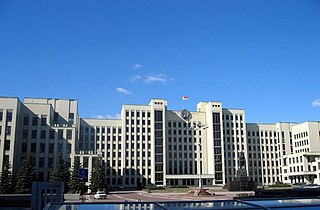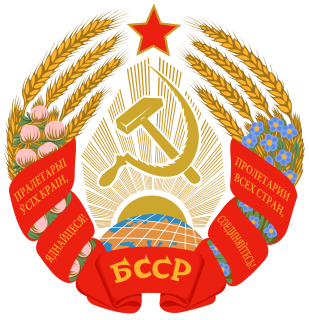 W
WThe Government of the Republic of Belarus, which consists of the Council of Ministers of the Republic of Belarus, is the executive branch of state power in Belarus, and it is appointed by the President of Belarus. The head of the Government is the President of Belarus, who manages the main agenda of the government and direct the ministers. The National Assembly of Belarus is the continuation of the Supreme Soviet of the BSSR and acts as the functioning parliament for Belarus.
 W
WThe All Belarusian People's Assembly is a general meeting of the Belarusian Government with industry leaders and other top officials from every sector of the government.
 W
WThe Constitutional Court of Belarus is one of the top-tier courts in the eastern European country. Created in 1994, the Court is run under guidelines that were issued in 1997. The purpose of the court is to render justice in areas where the constitution has come into question, such as a local law contradicting the constitution. There are 12 judges that sit on the bench, with all having degrees in legal studies, as required by Belarusian law. Six of the judges are appointed by the President while the other six are appointed by the Council of the Republic. Regardless of the manner of appointment, the judges sit on the bench for a term of 11 years.
 W
WThe Council of the Republic of the National Assembly of the Republic of Belarus is the upper house of the parliament of Belarus.
 W
WThe Economic Court of Belarus is one of three top-tier court systems in the Republic of Belarus. The main jurisdiction of the court is dealing with economic, enterprise and monetary disputes between the national government and local governments or citizens. Cases dealing with state secrets are also heard in the court, which is based in the national capital of Minsk.
 W
WThe Government House or House of Government is a government building in Minsk located on Independence Square. It houses the National Assembly of Belarus and its two chambers: the Council of the Republic and the House of Representatives. The National Assembly is one of the highest organs of national power and symbolism in the country. It was built in 1934 and designed by Iosif Langbard. It stands behind a statue of Vladimir Lenin and is one of the few buildings that survived the Great Patriotic War.
 W
WViktor Vladimirovich Gulevich is a Belarusian general who is the current Chief of the General Staff of the Armed Forces of Belarus.
 W
WThe House of Representatives of the National Assembly of the Republic of Belarus is the lower house of the parliament of Belarus. It was established after the Constitution of Belarus was amended in 1996, replacing the Supreme Council of Belarus.
 W
WViktor Gennadievich Khrenin is a senior leader in the Belarusian Armed Forces and the current Minister of Defense.
 W
WThe Ministry of Emergency Situations of Belarus is a government agency overseeing emergency services in Belarus. It is responsible for protecting the Belarusian people during natural disasters. It is located on Revaliucyjnaja Street in Minsk. The Ministry for Emergency Situations was established in accordance a decree of President Alexander Lukashenko on September 23, 1994.
 W
WThe National Assembly of the Republic of Belarus is the bicameral parliament of Belarus. The two chambers of the National Assembly are:Council of the Republic - The upper house House of Representatives - The lower house
 W
WOperations and Analysis Center under the President of the Republic of Belarus is a government agency in charge of regulating the protection of classified information, including state secrets of the Republic of Belarus or other information, which is protected in line with the legislation, against leakage by technical channels, against unsanctioned and unintended actions.
 W
WThe Palace of the Republic is a palatial government building in Minsk, Belarus. It is used for official state functions including forums, meetings, conventions, multi-genre concerts, symphony orchestras, and New Year's events.
 W
WThe president of the Republic of Belarus is the head of state of Belarus. The office was created in 1994 with the passing of the Constitution of Belarus by the Supreme Soviet. This replaced the office of Chairman of the Supreme Soviet as the head of state. The tasks of the president include executing foreign and domestic policy, defending the rights and general welfare of citizens and residents, and upholding the Constitution. The president is mandated by the Constitution to serve as a leader in the social affairs of the country and to act as its main representative abroad. The duties, responsibilities and other transitional clauses dealing with the presidency are listed in Chapter Three, Articles 79 through 89, of the Constitution.
 W
WThe prime minister of the Republic of Belarus is the office of the head of government of Belarus. Until 1991, it was known as the Chairman of the Council of Ministers of the Byelorussian Soviet Socialist Republic as the head of the government of the constituent republic of the Soviet Union.
 W
WLieutenant General Andrei Alekseyevich Ravkov is a Belarusian General and military leader who last served as the State Secretary of the Security Council of Belarus in 2020.
 W
WThe Security Council of Belarus is an interdepartmental body with a mandate to ensure the security of the Republic of Belarus. It considers internal and external affairs of the state with regard to the interest of maintaining security and defense. The Council was established upon the adoption of Resolution +1249 on 15 November 1991. The current Secretary of the Council is Alexander Volfovich.
 W
WThe State Border Committee of the Republic of Belarus, GPK manages the international borders of Belarus. Its armed paramilitary force is known as the Border Guard Service, It carries out committee orders and policy. The service covers the borders with Russia, Ukraine, Poland, Lithuania and Latvia.
 W
WThe Supreme Council of the Republic of Belarus, sometimes translated as Supreme Soviet of the Republic of Belarus, was the unicameral legislature of Belarus between 1991 and 1996.
 W
WThe Supreme Court of the Republic of Belarus is the highest-tier court inside of Belarus and acts as the final "court of review." Its general tasks include the oversight of lower-tier courts and can render justice in areas of general civil and criminal law. Unlike the United States Supreme Court, constitutional issues are not sent to the Belarusian Supreme Court, but are sent to a separate court called the Constitutional Court. The judges to the Supreme Court are appointed by the president.
 W
WThe Supreme Soviet of the Byelorussian SSR was the supreme soviet of the Byelorussian SSR from 1938 to 1991. The Supreme Soviet of the Byelorussian SSR was preceded by the All-Byelorussian Central Executive Committee (1920-1938) and the All-Byelorussian Congress of Soviets (1919-1937). The Supreme Soviet of the Byelorussian SSR was briefly disbanded in 1941 due to the Great Patriotic War and was re-established in 1947. The Supreme Soviet of the Byelorussian SSR was briefly succeeded by the Supreme Soviet of Belarus from 1991 to 1996. The Supreme Soviet of Belarus was succeeded by the National Assembly of Belarus in 1996.
 W
WAlexander Grigoryevich Volfovich is a Belarusian general who is the current Secretary of the State Security Council of the Republic of Belarus. He is also a former Chief of the General Staff of the Armed Forces of Belarus.
 W
WLieutenant-General Yuri Viktorovich Zhadobin was the Chairman of the KGB of the Republic of Belarus from 2007 to 2008 and the Minister of Defence of Belarus from 4 December 2009 to 27 November 2014. He replaced Leonid Maltsev and was succeeded by Andrei Ravkov. Zhadobin was subject to international sanctions as a person responsible for political repressions and human rights violations in Belarus.